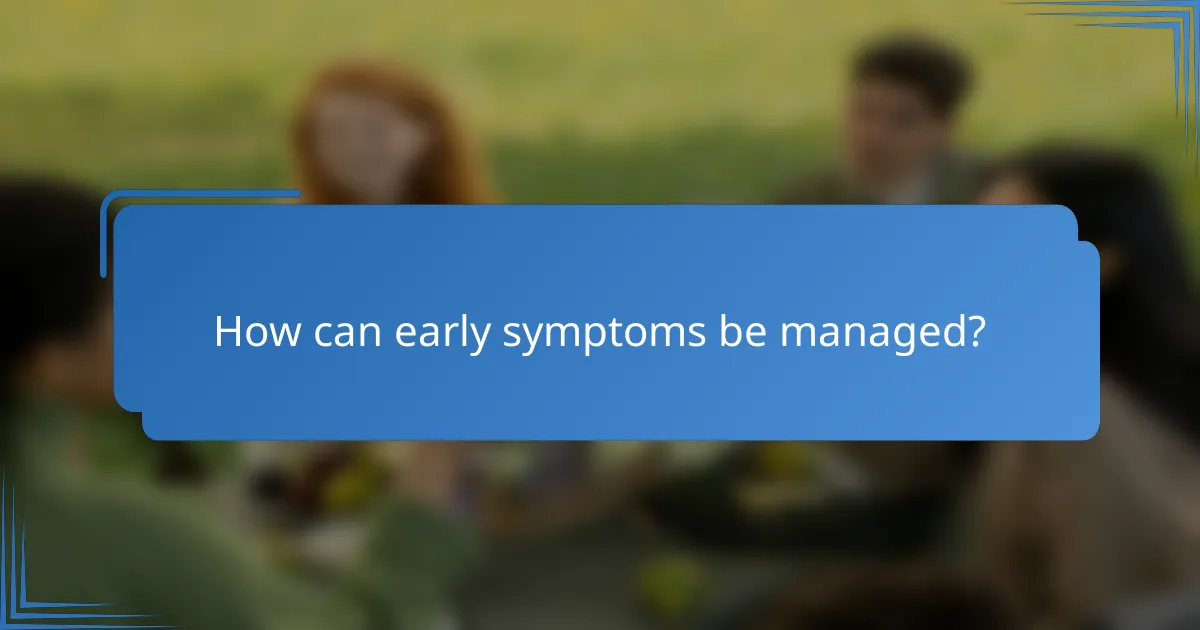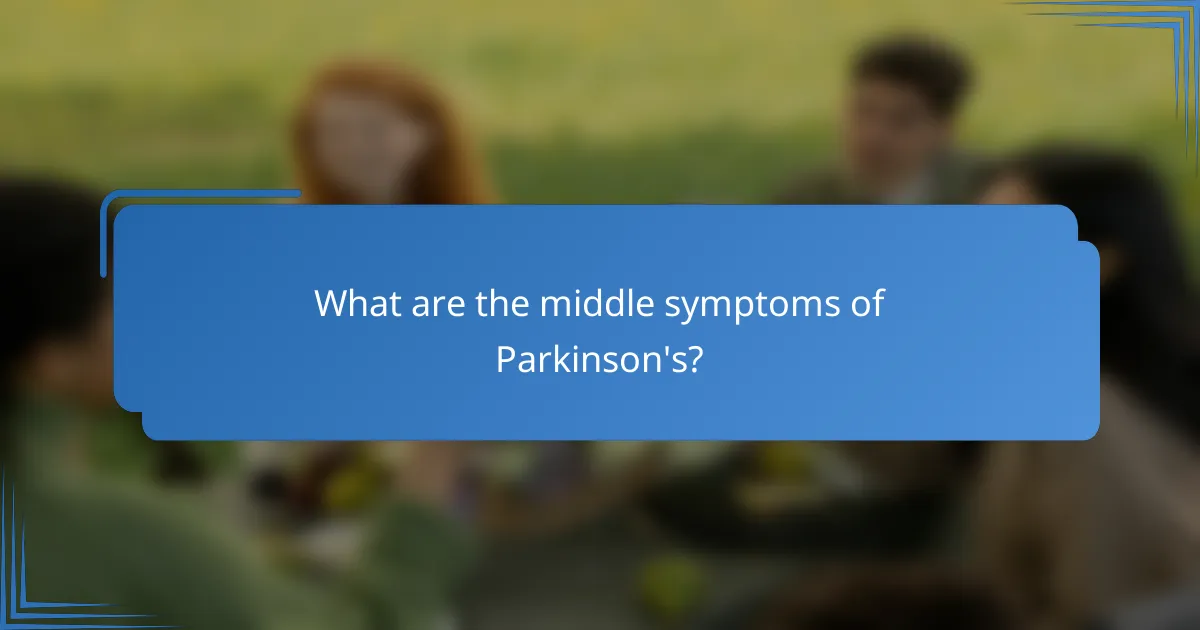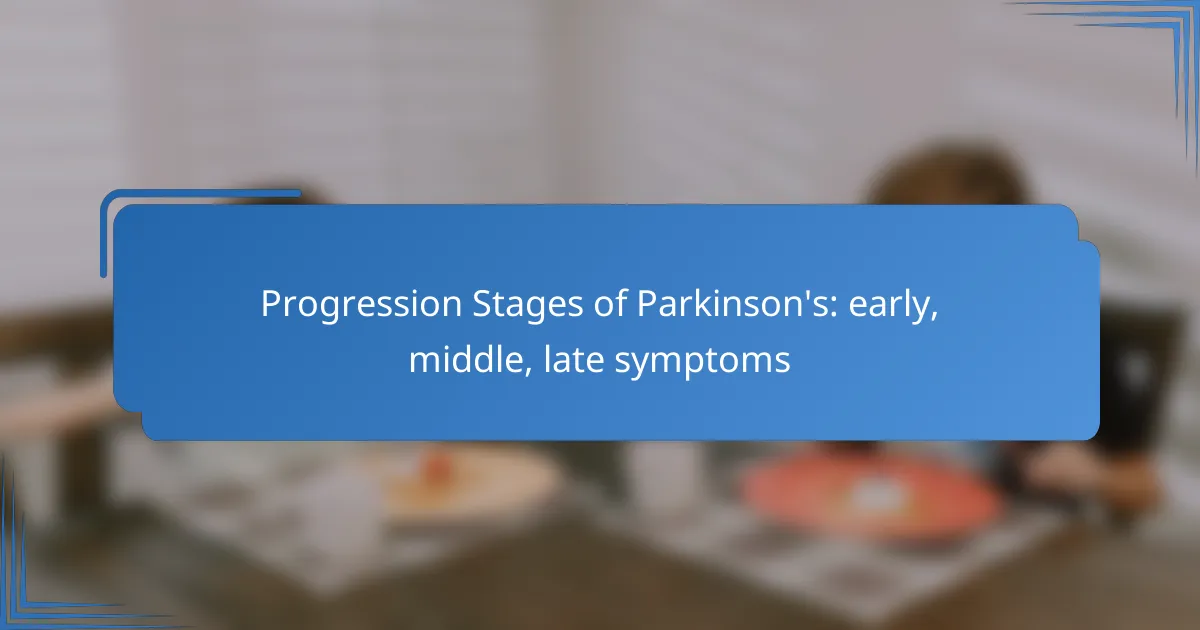Parkinson’s disease progresses through distinct stages, each characterized by specific symptoms that can significantly impact daily life. Early symptoms may be subtle and easily overlooked, making early recognition essential for effective management. As the disease advances to the middle stage, individuals often experience more pronounced changes in mobility and communication, necessitating adjustments in care and support. Understanding these progression stages is vital for improving quality of life throughout the journey with Parkinson’s.

What are the early symptoms of Parkinson’s in New Zealand?
The early symptoms of Parkinson’s in New Zealand often include subtle changes that can be easily overlooked. Recognizing these signs early can lead to timely diagnosis and management, which is crucial for maintaining quality of life.
Tremors
Tremors are one of the most recognizable early symptoms of Parkinson’s. They typically start in one hand or foot and may appear as a slight shaking or rhythmic movement when the limb is at rest. In New Zealand, these tremors can be mistaken for normal aging or stress, making awareness important.
These tremors may also occur in other parts of the body, such as the jaw or face. While they can be distressing, they often fluctuate in intensity and may not be present during movement.
Bradykinesia
Bradykinesia refers to the slowness of movement, which can significantly impact daily activities. Individuals may notice that routine tasks, such as buttoning a shirt or walking, take longer than before. In New Zealand, this symptom can lead to frustration and decreased independence.
As bradykinesia progresses, it may become more challenging to initiate movements, leading to a shuffling gait or difficulty in starting to walk. Recognizing this symptom early can help in seeking appropriate interventions.
Muscle stiffness
Muscle stiffness, or rigidity, is another common early symptom of Parkinson’s. This stiffness can affect the arms, legs, and neck, leading to discomfort and reduced range of motion. In New Zealand, individuals may describe feeling like their muscles are tight or heavy.
This symptom can contribute to a stooped posture and may be accompanied by pain or soreness. Early identification and treatment can help manage stiffness and improve mobility, enhancing overall quality of life.

How can early symptoms be managed?
Managing early symptoms of Parkinson’s involves a combination of medication, physical therapy, and lifestyle changes. These strategies can help improve quality of life and maintain mobility as the disease progresses.
Medication options
Medications are often the first line of defense in managing early Parkinson’s symptoms. Levodopa is commonly prescribed to help replenish dopamine levels, which can alleviate motor symptoms. Other options include dopamine agonists and MAO-B inhibitors, which may be used alone or in combination.
It’s essential to work closely with a healthcare provider to determine the most effective medication regimen, as individual responses can vary significantly. Regular follow-ups can help adjust dosages and minimize side effects.
Physical therapy
Physical therapy plays a crucial role in managing early Parkinson’s symptoms by improving strength, flexibility, and balance. A physical therapist can design a personalized exercise program that focuses on specific needs and goals, helping to maintain mobility and reduce the risk of falls.
Incorporating activities such as stretching, resistance training, and balance exercises can enhance overall physical function. Consistency is key, so aim for regular sessions and practice exercises at home as recommended.
Lifestyle changes
Making lifestyle changes can significantly impact the management of early Parkinson’s symptoms. A balanced diet rich in fruits, vegetables, and whole grains can support overall health and well-being. Staying hydrated and limiting caffeine and alcohol can also be beneficial.
Additionally, engaging in social activities and hobbies can improve mental health and provide emotional support. Establishing a daily routine that includes physical activity, relaxation techniques, and social interaction can help maintain a positive outlook and enhance quality of life.

What are the middle symptoms of Parkinson’s?
The middle symptoms of Parkinson’s disease often involve significant changes in mobility and communication. These symptoms can impact daily life and may require adjustments in care and support.
Postural instability
Postural instability refers to difficulties in maintaining balance and stability while standing or moving. Individuals may experience frequent falls or a tendency to lean forward or backward, which can increase the risk of injury.
To manage postural instability, physical therapy can be beneficial. Exercises focusing on balance, strength, and coordination are often recommended. Using assistive devices like canes or walkers may also help improve stability.
Speech changes
Speech changes in Parkinson’s can manifest as softer voice volume, slurred speech, or a monotone quality. These alterations can make communication challenging and may lead to frustration for both the individual and their listeners.
Speech therapy is a valuable resource for addressing these changes. Practicing vocal exercises and learning techniques to enhance clarity can improve communication skills. Family members can also support by encouraging clear and patient conversations.
Difficulty with daily activities
As Parkinson’s progresses, individuals may find it increasingly difficult to perform daily activities such as dressing, eating, or grooming. Fine motor skills can decline, making tasks that require dexterity more challenging.
Adaptive tools and strategies can aid in maintaining independence. For instance, using utensils with larger grips or wearing clothing with easy fasteners can simplify tasks. Occupational therapy can provide personalized recommendations to enhance daily functioning.

How can middle symptoms be addressed?
Addressing middle symptoms of Parkinson’s involves a combination of therapies, assistive devices, and support systems. These strategies aim to enhance daily functioning and improve quality of life for individuals experiencing these symptoms.
Occupational therapy
Occupational therapy focuses on helping individuals with Parkinson’s maintain their independence in daily activities. Therapists assess specific challenges and develop personalized strategies to manage tasks such as dressing, cooking, and personal care.
Techniques may include adaptive methods, environmental modifications, and training in the use of assistive tools. Regular sessions can help individuals adapt to changes in their abilities and find new ways to perform everyday tasks.
Assistive devices
Assistive devices can significantly improve mobility and safety for those experiencing middle symptoms of Parkinson’s. Common devices include walkers, canes, and grab bars, which provide support and stability during movement.
Additionally, specialized utensils and tools can help with eating and personal care, making these activities easier and more manageable. It’s essential to consult with healthcare professionals to select the most appropriate devices based on individual needs.
Support groups
Support groups offer a valuable resource for individuals with Parkinson’s and their families. These groups provide a platform for sharing experiences, coping strategies, and emotional support, which can be crucial during the middle stages of the disease.
Participating in a support group can also help reduce feelings of isolation and provide access to information about managing symptoms. Many organizations offer both in-person and online options, making it easier to find a suitable group regardless of location.

What are the late symptoms of Parkinson’s?
Late symptoms of Parkinson’s disease often include significant cognitive decline, severe mobility issues, and emotional changes. These symptoms can greatly impact daily functioning and quality of life, requiring comprehensive management strategies.
Cognitive decline
Cognitive decline in late-stage Parkinson’s can manifest as memory problems, difficulty concentrating, and impaired judgment. Patients may struggle with tasks that require planning or multitasking, which can lead to frustration and confusion.
It’s essential to monitor cognitive changes closely. Engaging in mental exercises, such as puzzles or memory games, may help maintain cognitive function. Additionally, discussing any noticeable changes with healthcare providers can lead to appropriate interventions.
Severe mobility issues
Severe mobility issues often arise in the late stages of Parkinson’s, characterized by significant difficulty in walking, balance problems, and increased risk of falls. Patients may experience a shuffling gait and may require assistance for daily activities.
To manage mobility challenges, physical therapy can be beneficial. Simple exercises focusing on strength and balance can help improve stability. Using mobility aids, like walkers or canes, may also enhance safety and independence.
Emotional changes
Emotional changes are common in the late stages of Parkinson’s, with many patients experiencing depression, anxiety, or apathy. These feelings can stem from the disease’s progression and the challenges of coping with physical limitations.
Addressing emotional health is crucial. Support groups, counseling, and medication can provide relief. Encouraging open communication about feelings with family and caregivers can foster a supportive environment, helping patients feel less isolated.

How can late symptoms be supported?
Supporting late symptoms of Parkinson’s involves a combination of advanced care planning, palliative care options, and family support strategies. These approaches aim to enhance quality of life and ensure that patients receive appropriate care tailored to their needs.
Advanced care planning
Advanced care planning is essential for individuals with late-stage Parkinson’s. It involves discussing and documenting preferences for medical treatment and end-of-life care, ensuring that the patient’s wishes are respected. This can include decisions about resuscitation, feeding tubes, and hospice care.
Engaging in these discussions early allows families to understand the patient’s values and desires. Utilizing tools like advance directives and living wills can help clarify these preferences legally and ethically.
Palliative care options
Palliative care focuses on providing relief from the symptoms and stress of Parkinson’s disease. It is available at any stage and can be integrated alongside curative treatments. This type of care aims to improve quality of life through pain management, emotional support, and assistance with daily activities.
Patients and families should consider consulting with a palliative care team, which may include doctors, nurses, and social workers. This team can help navigate treatment options and provide resources for managing symptoms effectively.
Family support strategies
Family support is crucial for individuals with late-stage Parkinson’s. Families should establish a support network that includes caregivers, healthcare professionals, and community resources. This network can provide emotional and practical assistance, helping to alleviate caregiver stress.
Encouraging open communication among family members about the patient’s needs and preferences fosters a collaborative environment. Additionally, exploring local support groups can connect families with others facing similar challenges, offering shared experiences and coping strategies.
